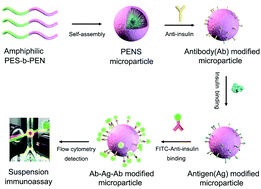Synthesis and self-assembly of polyethersulfone-based amphiphilic block copolymers as microparticles for suspension immunosensors†
Abstract
Polyethersulfone (PES) is one of the most widely used high-performance polymers in biomedicine due to its unique combination of mechanical properties and biocompatibility. However, the intrinsic hydrophobicity of PES hinders its biomedical application efficiency because of biofouling or non-specific adsorption concerns, which could be mitigated by introducing hydrophilic moieties into PES. In this work, we have synthesized, for the first time, a novel amphiphilic block copolymer named as amPENS containing both the hydrophobic PES segment and the hydrophilic polyarylene ether nitrile (PEN) segment. Furthermore, the synthesized amPENS has been transformed into sub-micrometer-sized microparticles via the emulsion solvent evaporation-induced self-assembly, and the size as well as fine morphology of the obtained PENS microparticles can be readily modulated by varying different experimental parameters. Finally, as a proof-of-concept application, the monoclonal antibody against insulin has been covalently immobilized on the surface of the optimized PENS microparticles, which allows specific qualitative discrimination of insulin in a suspension immunoassay via flow cytometry.



 Please wait while we load your content...
Please wait while we load your content...